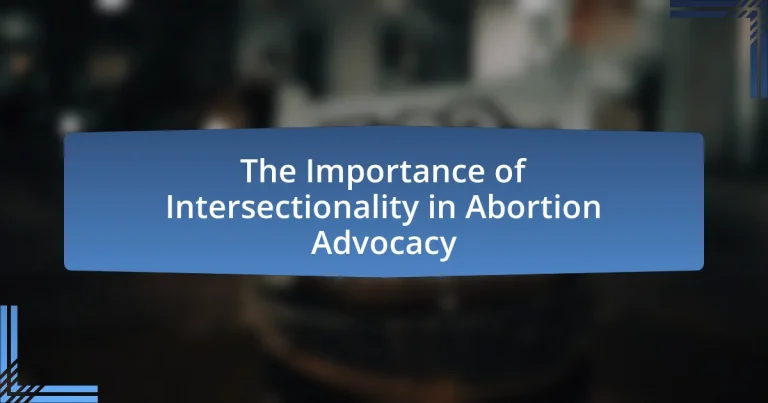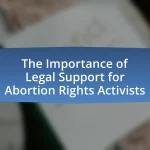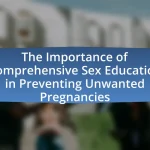The article focuses on the significance of intersectionality in abortion advocacy, emphasizing how various social identities—such as race, gender, class, and sexuality—intersect to shape individuals’ experiences with reproductive rights. It highlights the unique barriers faced by marginalized communities, particularly women of color and low-income individuals, in accessing abortion services due to systemic inequalities. The discussion includes the impact of socioeconomic factors, cultural stigma, and the necessity for inclusive policies that address these complexities. Additionally, the article outlines best practices for advocates to integrate intersectional approaches into their strategies, ensuring that diverse voices are represented in the discourse surrounding abortion rights.
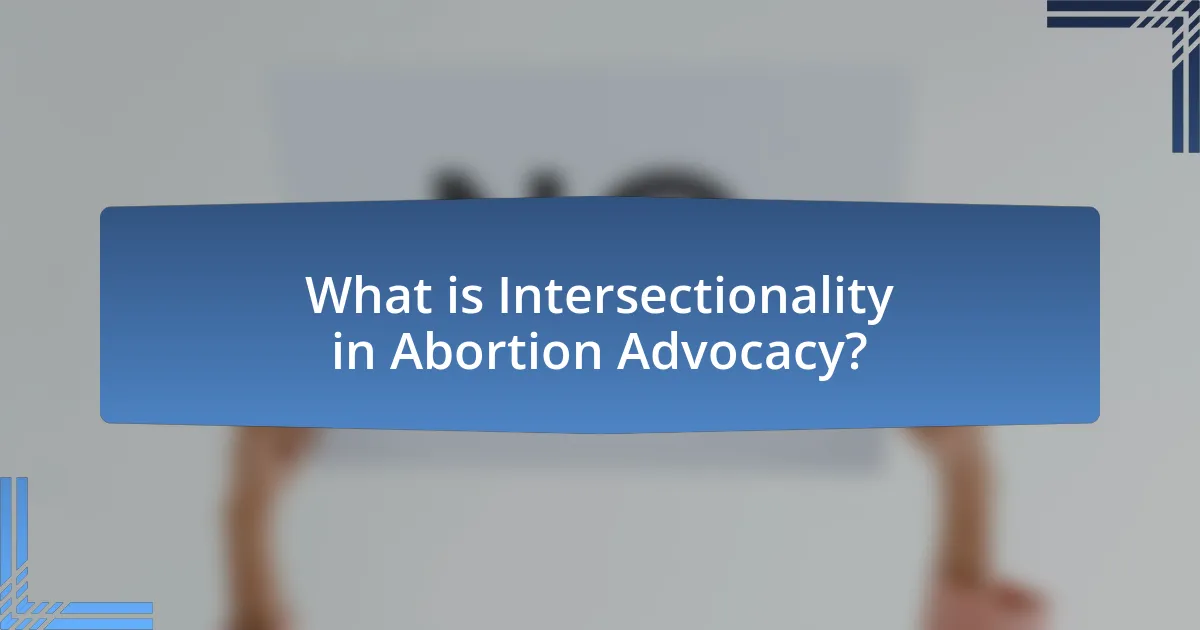
What is Intersectionality in Abortion Advocacy?
Intersectionality in abortion advocacy refers to the framework that examines how various social identities, such as race, gender, class, and sexuality, intersect to create unique experiences of oppression and privilege in the context of reproductive rights. This approach recognizes that individuals do not experience discrimination or access to healthcare in isolation; rather, their experiences are shaped by multiple, overlapping identities. For instance, Black women may face different barriers to abortion access compared to white women due to systemic racism and socioeconomic factors. Research by the Center for Reproductive Rights highlights that marginalized communities often encounter greater obstacles in accessing reproductive healthcare, underscoring the necessity of an intersectional lens in advocacy efforts to ensure equitable access for all individuals.
How does intersectionality influence the discourse around abortion rights?
Intersectionality significantly influences the discourse around abortion rights by highlighting how various social identities, such as race, class, gender, and sexuality, intersect to shape individuals’ experiences and access to reproductive healthcare. This framework reveals that marginalized groups, particularly women of color and low-income individuals, face compounded barriers to accessing abortion services, including systemic racism, economic inequality, and lack of healthcare resources. For instance, studies show that Black women are disproportionately affected by restrictive abortion laws and face higher rates of maternal mortality, underscoring the need for an intersectional approach in advocacy efforts. By incorporating intersectionality, the discourse around abortion rights becomes more inclusive, addressing the unique challenges faced by diverse populations and advocating for policies that consider these complexities.
What are the key components of intersectionality in this context?
The key components of intersectionality in the context of abortion advocacy include the recognition of overlapping social identities, the impact of systemic inequalities, and the necessity for inclusive policies. Intersectionality emphasizes that individuals experience discrimination and privilege differently based on their race, gender, socioeconomic status, and other identities, which affects their access to abortion services. For instance, research by Crenshaw (1989) highlights how Black women face unique barriers to reproductive healthcare due to both racism and sexism, illustrating the need for advocacy that addresses these intersecting factors. This approach ensures that the voices of marginalized groups are included in the conversation, leading to more equitable healthcare policies.
How do different identities intersect to shape individual experiences with abortion?
Different identities, such as race, socioeconomic status, gender identity, and sexual orientation, intersect to shape individual experiences with abortion by influencing access to healthcare, societal stigma, and personal beliefs. For instance, women of color often face systemic barriers, including discrimination and lack of resources, which can limit their access to abortion services compared to their white counterparts. Research from the Guttmacher Institute indicates that low-income individuals are disproportionately affected by restrictive abortion laws, as they may lack the financial means to travel to facilities or afford the procedure itself. Additionally, LGBTQ+ individuals may encounter unique challenges, such as discrimination from healthcare providers, which can further complicate their experiences with abortion. These intersecting identities create a complex landscape where individual experiences with abortion are not uniform but rather shaped by a multitude of social, economic, and cultural factors.
Why is intersectionality crucial for effective abortion advocacy?
Intersectionality is crucial for effective abortion advocacy because it recognizes and addresses the diverse experiences and barriers faced by individuals based on their intersecting identities, such as race, gender, socioeconomic status, and sexual orientation. This approach ensures that advocacy efforts are inclusive and responsive to the unique challenges that marginalized groups encounter in accessing abortion services. For instance, research by the Guttmacher Institute indicates that women of color and low-income individuals face higher rates of unintended pregnancies and greater obstacles to accessing abortion care, highlighting the need for tailored advocacy strategies that consider these disparities. By incorporating intersectionality, abortion advocacy can more effectively mobilize resources, shape policies, and create supportive environments that uphold reproductive rights for all individuals, particularly those who are most vulnerable.
What are the potential consequences of ignoring intersectionality in advocacy efforts?
Ignoring intersectionality in advocacy efforts can lead to ineffective strategies that fail to address the diverse needs of marginalized groups. This oversight can result in the perpetuation of systemic inequalities, as advocacy may prioritize the experiences of a dominant group while neglecting those of individuals facing multiple forms of discrimination, such as race, gender, and socioeconomic status. For instance, research by the American Psychological Association highlights that marginalized women often face compounded barriers to accessing reproductive healthcare, which are overlooked when intersectionality is not considered. Consequently, advocacy efforts may not only be less effective but can also alienate the very communities they aim to support, ultimately undermining the goals of social justice and equity.
How can intersectional approaches enhance the inclusivity of abortion advocacy?
Intersectional approaches enhance the inclusivity of abortion advocacy by recognizing and addressing the diverse experiences and needs of individuals affected by abortion. This framework acknowledges that factors such as race, class, gender identity, sexual orientation, and disability intersect to shape people’s access to reproductive healthcare and their experiences with abortion. For instance, research from the Guttmacher Institute indicates that marginalized communities, including women of color and low-income individuals, face greater barriers to accessing abortion services, highlighting the necessity of tailored advocacy efforts that consider these intersecting identities. By incorporating intersectionality, abortion advocacy can create more equitable policies and support systems that address the unique challenges faced by different groups, ultimately fostering a more inclusive movement.

What are the challenges faced by marginalized groups in abortion access?
Marginalized groups face significant challenges in accessing abortion services, including socioeconomic barriers, lack of healthcare resources, and systemic discrimination. For instance, low-income individuals often cannot afford the costs associated with abortion, including travel and procedure fees, which can be exacerbated by restrictive state laws. Additionally, marginalized communities frequently experience limited availability of clinics, particularly in rural areas, leading to increased travel distances and time constraints. Research indicates that Black and Latina women are disproportionately affected by these barriers, as they are more likely to encounter both financial and logistical obstacles when seeking reproductive healthcare. Furthermore, systemic racism and stigma can deter individuals from seeking necessary services, compounding the difficulties faced by these groups.
How do socioeconomic factors impact access to abortion services?
Socioeconomic factors significantly impact access to abortion services by influencing individuals’ financial resources, education, and geographic location. Individuals with lower income levels often face barriers such as the inability to afford the procedure, transportation challenges to clinics, and lack of health insurance coverage. For instance, a study by the Guttmacher Institute found that 75% of women who seek abortions are low-income, highlighting the correlation between economic status and access. Additionally, education levels affect awareness of available services and reproductive rights, while geographic disparities can limit access in rural areas where clinics may be scarce. These factors collectively create a landscape where socioeconomic status directly determines the ability to obtain abortion services.
What role does income inequality play in abortion access?
Income inequality significantly impacts abortion access by creating disparities in healthcare affordability and availability. Individuals with lower incomes often face financial barriers that limit their ability to obtain abortion services, as they may lack insurance coverage or the means to pay out-of-pocket costs. According to the Guttmacher Institute, women in the lowest income brackets are more likely to experience unintended pregnancies and have less access to reproductive healthcare, including abortion services. This economic disadvantage exacerbates existing inequalities, making it more difficult for marginalized groups to exercise their reproductive rights.
How do systemic barriers affect marginalized communities’ access to reproductive health?
Systemic barriers significantly hinder marginalized communities’ access to reproductive health by creating obstacles such as economic disparities, lack of transportation, and inadequate healthcare infrastructure. For instance, low-income individuals often face financial constraints that limit their ability to afford reproductive health services, including contraception and abortion. According to the Guttmacher Institute, 75% of women who seek abortions are low-income, highlighting the economic challenges they encounter. Additionally, marginalized communities frequently reside in areas with fewer healthcare facilities, making it difficult to access necessary services. A study published in the American Journal of Public Health found that women of color are disproportionately affected by these barriers, leading to higher rates of unintended pregnancies and poorer health outcomes. These systemic issues underscore the urgent need for targeted interventions to improve reproductive health access for marginalized populations.
What specific barriers do people of color face in abortion advocacy?
People of color face systemic barriers in abortion advocacy, including racial discrimination, socioeconomic disparities, and limited access to healthcare resources. Racial discrimination manifests in the form of biased attitudes from healthcare providers, which can deter individuals from seeking necessary services. Socioeconomic disparities often result in lower income levels, making it difficult for people of color to afford abortion services or travel to clinics. Additionally, limited access to healthcare resources, particularly in underserved communities, restricts availability of reproductive health services, including abortion. According to the Guttmacher Institute, Black and Latina women are disproportionately affected by these barriers, highlighting the urgent need for intersectional approaches in abortion advocacy.
How does racial discrimination manifest in healthcare settings related to abortion?
Racial discrimination in healthcare settings related to abortion manifests through unequal access to services, biased treatment by healthcare providers, and systemic barriers that disproportionately affect marginalized racial groups. Studies indicate that Black and Latina women face higher rates of stigma and discrimination when seeking abortion care, which can lead to delays in obtaining services or avoidance of care altogether. For instance, a report by the Guttmacher Institute highlights that women of color are more likely to encounter obstacles such as lack of transportation, financial constraints, and fewer available clinics in their communities, which exacerbates health disparities. Additionally, implicit biases among healthcare providers can result in inadequate counseling and support, further marginalizing these populations in reproductive healthcare.
What are the implications of cultural stigma on abortion within different communities?
Cultural stigma surrounding abortion significantly impacts access to reproductive healthcare and the mental well-being of individuals within various communities. In communities where abortion is heavily stigmatized, individuals may experience feelings of shame, isolation, and fear of judgment, which can deter them from seeking necessary medical care. For instance, a study published in the American Journal of Public Health found that women in stigmatized environments are less likely to disclose their abortion experiences, leading to a lack of support and increased psychological distress. Furthermore, cultural stigma can influence policy decisions, resulting in restrictive laws that limit access to abortion services, disproportionately affecting marginalized groups. This intersection of stigma and access highlights the need for culturally sensitive advocacy that addresses the unique challenges faced by different communities in relation to abortion.
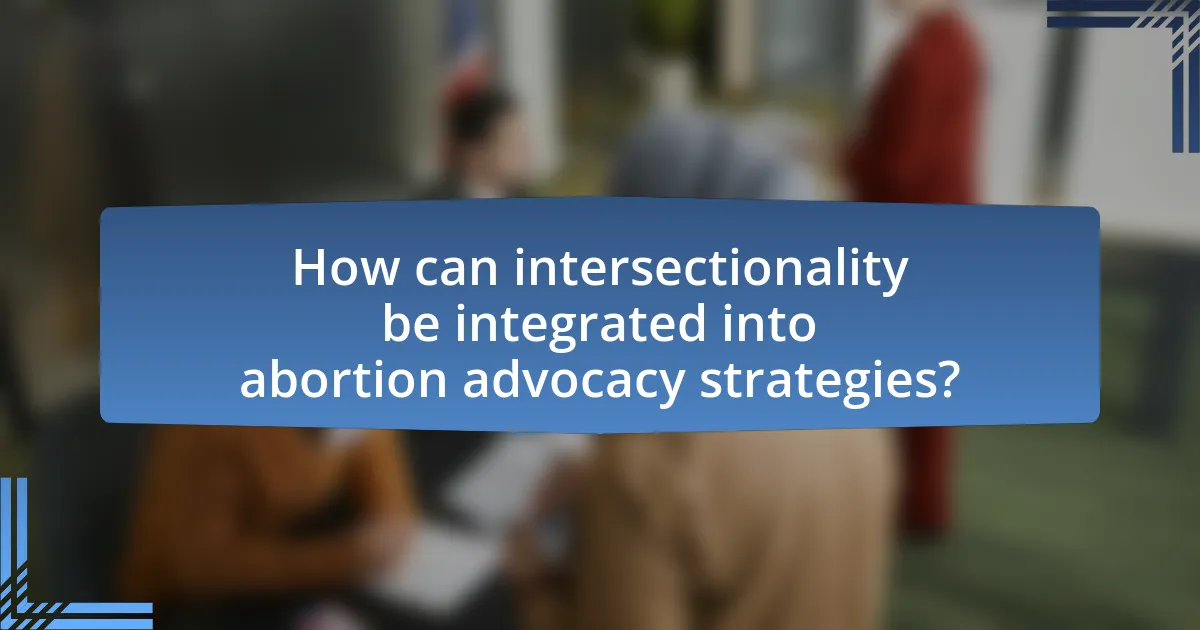
How can intersectionality be integrated into abortion advocacy strategies?
Intersectionality can be integrated into abortion advocacy strategies by recognizing and addressing the diverse experiences and needs of individuals affected by abortion access. This approach involves tailoring advocacy efforts to consider factors such as race, socioeconomic status, gender identity, and geographic location, which influence individuals’ access to reproductive healthcare. For instance, studies show that marginalized communities, including women of color and low-income individuals, face greater barriers to accessing abortion services, highlighting the need for targeted outreach and support. By incorporating intersectional analysis, advocacy groups can develop policies and campaigns that address these disparities, ensuring that all voices are represented and that resources are allocated equitably.
What best practices can advocates adopt to ensure intersectional approaches?
Advocates can adopt best practices such as actively engaging diverse communities, incorporating multiple perspectives, and prioritizing inclusive language to ensure intersectional approaches. Engaging diverse communities involves outreach to marginalized groups affected by abortion policies, ensuring their voices and experiences shape advocacy efforts. Incorporating multiple perspectives means recognizing how various identities—such as race, gender, socioeconomic status, and sexual orientation—intersect and influence individuals’ experiences with abortion. Prioritizing inclusive language ensures that all individuals feel represented and respected in advocacy materials, fostering a sense of belonging and empowerment. These practices are supported by research indicating that intersectional advocacy leads to more effective and equitable outcomes in reproductive health policies.
How can collaboration with diverse communities enhance advocacy efforts?
Collaboration with diverse communities enhances advocacy efforts by incorporating a wider range of perspectives and experiences, which leads to more effective and inclusive strategies. When advocacy groups engage with various communities, they can identify unique challenges and barriers faced by different populations, allowing for tailored approaches that resonate more deeply with those affected. For instance, research by the Center for American Progress highlights that inclusive advocacy efforts can increase support for policies by 30% when they reflect the voices of marginalized groups. This collaboration not only strengthens the legitimacy of the advocacy but also fosters solidarity and collective action, ultimately driving more impactful change in policies related to abortion and reproductive rights.
What role does education play in promoting intersectional understanding in abortion advocacy?
Education plays a crucial role in promoting intersectional understanding in abortion advocacy by equipping individuals with knowledge about the diverse experiences and challenges faced by different communities regarding reproductive rights. This understanding fosters empathy and solidarity among advocates, enabling them to address the unique barriers that marginalized groups encounter, such as socioeconomic status, race, and gender identity. Research indicates that comprehensive education on intersectionality can lead to more inclusive policies and practices, as seen in initiatives that incorporate the voices of women of color and LGBTQ+ individuals in reproductive health discussions. By highlighting these varied perspectives, education not only informs advocacy strategies but also strengthens the overall movement for reproductive justice.
What are the key takeaways for effective intersectional abortion advocacy?
Effective intersectional abortion advocacy requires understanding and addressing the diverse needs of marginalized communities. Advocates must prioritize inclusivity by recognizing how factors such as race, socioeconomic status, gender identity, and disability intersect to impact access to abortion services. Research indicates that marginalized groups face higher barriers to reproductive healthcare; for instance, Black women are disproportionately affected by restrictive abortion laws and lack of access to services. Additionally, building coalitions with various organizations can amplify voices and create a more comprehensive approach to advocacy. Engaging in active listening and incorporating feedback from those directly affected ensures that advocacy efforts are relevant and effective.
How can advocates measure the impact of intersectional strategies on abortion access?
Advocates can measure the impact of intersectional strategies on abortion access by analyzing data on access disparities among different demographic groups. This involves collecting quantitative data on abortion rates, service availability, and barriers faced by marginalized communities, such as low-income individuals and people of color. For instance, studies have shown that Black women are disproportionately affected by restrictive abortion laws, with a 2019 report from the Guttmacher Institute indicating that they are more likely to face obstacles in accessing care compared to white women. By employing qualitative methods, such as interviews and focus groups, advocates can gain insights into the lived experiences of individuals affected by these disparities. This combination of quantitative and qualitative data allows for a comprehensive understanding of how intersectional strategies influence abortion access and highlights areas needing targeted advocacy efforts.
What resources are available for advocates to learn more about intersectionality in abortion advocacy?
Advocates can access various resources to learn about intersectionality in abortion advocacy, including academic journals, online courses, and organizations focused on reproductive justice. Notable resources include the “Reproductive Justice: An Introduction” by Loretta Ross and Rickie Solinger, which provides foundational knowledge on the intersection of race, class, and gender in reproductive rights. Additionally, the National Women’s Law Center offers webinars and toolkits that address intersectionality in reproductive health. The Center for Reproductive Rights also publishes reports and articles that highlight the importance of considering diverse identities in abortion advocacy. These resources collectively enhance understanding and inform advocacy strategies that are inclusive and effective.
